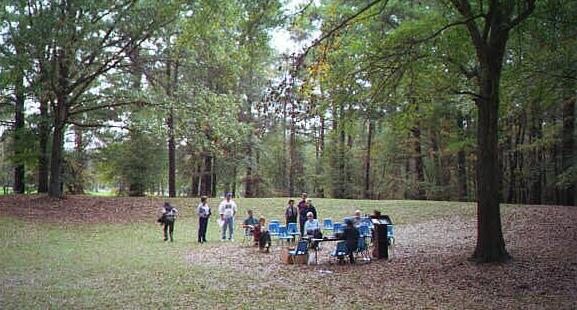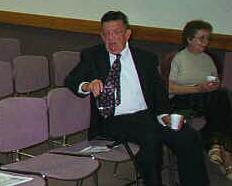|
After Atlanta fell on September
3, 1864, Major General William Tecumseh Sherman,
Commander of the Military Division of the Mississippi, consolidated his
hold
on that important city and planned his next move. His plan was to move
a
large portion of his three field armies through Georgia to Savannah on
the
seacoast, thereby bringing war to the civilian population of what he
termed
"their best state." Accordingly, he sought and received approval for
his
plans from Lieutenant General Ulysses S. Grant, Commander of all the
Federal
armies, Secretary of War Edwin M. Stanton, and, of course, Prsident
Abraham
Lincoln. Sherman burned Atlanta's business district and other parts of
the
city on November 15, and began his destructive March to the Sea. He had
sent
back the Army of the Cumberland under Major General George H. Thomas on
September
28, together with Major General John M. Schofield's Twenty-third Army
Corps
to hold Nashville and Middle Tennessee. His remaining force, 62,000
men,
consisting of the bulk of the Armies of the Ohio and the Tennessee, was
divided
into two wings. The left wing was directed to march down the tracks of
the
Atlanta and Augusta Railroad toward Social Circle and Madison.
For purposes of my
paper we will discuss the activities of the Right Wing
only. This wing, 30,000 strong, was commanded by Major General Oliver
Otis
Howard. It consisted of two corps, the Fifteenth under Major General
Peter
J. Osterhaus and the Seventeenth commanded by Major General Francis
Preston
Blair, Jr. Howard feinted south towards Columbus and Macon, then
crossed
the Ocmulgee River at Planter's Factory Ferry east of Indian Springs,
and
headed for Hillsboro. Marching through Hillsboro, the wing created a
path
of destruction through Blountville (which was burned to the ground),
Clinton,
and on to Gordon and Tennille. As it passed through Clinton, Sherman
ordered
Howard to make a demonstration against Macon in an effort to confuse
and
divide what forces the Confederates could bring against him.
Concern over
Sherman's plans caused Major General Howell Cobb, commanding
at Macon, to call for 500 additional slaves for 30 days to complete the
fortifications around Macon.
These works,
including the 10-gun fort located behind the Superintendent's
House at the Ocmulgee National Monument, were incomplete by the time
the
Federals reached Clinton. Furthermore, the troops available to contest
any
attempt to capture Macon were few. The Georgia Reserves led by Cobb and
commanded
in the field by his subordinate Major General Gustavus W. Smith,
included
2,800 infantry, 3 batteries of artillery, and 250 local reserve
cavalry.
Wheeler's Cavalry, stripped to provide reinforcements for Lieutenant
General
Nathan Bedford Forrest's Cavalry which accompanied Confederate General
John
Bell Hood, Commander of the Army of Tennessee, on an abortive invasion
of
Tennessee, numbered only 2,000. With these small forces it was
impossible
for Wheeler and Smith to make an effective defense against Sherman.
Howard sent a
portion of the Third Cavalry Division, led by Brigadier General
Hugh Judson Kilpatrick, toward Macon to attack the city and capture it
if
possible. Kilpatrick, in turn, divided his forces and ordered the
Second
Brigade, led by Colonel Smith D. Atkins, formerly commander of the
Ninety-Second
Illinois Mounted Infantry, to make the assault upon Macon.
Atkins' brigade,
which numbered less than 2,000 men, advanced toward the
city. On the afternoon of November 20, this force, consisting of six
regiments
of cavalry, one regiment of Mounted Infantry, accompanied by Captain
Yates
V. Beebe's Tenth Wisconsin Battery, which included mostly 12-pounder
howitzers,
appeared at the bridge carrying the tracks of the Georgia Central
Railroad
over Walnut Creek, within the current boundaries of the Ocmulgee
National
Monument.
The Confederate
force,which was placed on the crest and Eastern slope of
Dunlap's Hill, consisted of two regiments of convalescent troops from
Camp
Wright, the convalescent camp in Macon, supported by a detachment of
375
men led by a Captain Albough. The infantry was supported by artillery
units
of the Army of Tennessee Reserve Artillery, sent to Macon by Hood after
he
evacuated Atlanta. This force included Curry's Bellamy's Guist's,
Howell's,
Palmer's, Rivers', and Baxter's Batteries, some of whom were deployed
as
infantry. Forces in support of these units included a detachment of
seven
companies under Colonel T.S. Howe of the Twenty-fourth Tennessee
Regiment
and a volunteer company from the Blind School Hospital commanded by
Captain
Aikens. The entire force did not exceed 1,000 or 1,200 men. Colonel
T.M.
Colmes, Commander of the Fiftieth Tennessee Regiment and Commander of
Camp
Wright, led the Confederate forces. Colmes had been told that he had
cavalry
in his front which was advancing on the north and east sides of Walnut
Creek,
on all the roads leading to East Macon, than an area of scattered
houses
and farms.
At 3:30 P.M. Beebe's
guns opened fire upon the Confederate line. They were
answered by Rivers' and Howell's guns. Colmes then placed his entire
force
in line of battle and deployed a line of skirmishers. At this juncture
Atkins
ordered the Tenth Ohio Cavalry to charge a portion of Rivers' Battery
which
was placed in the road just west of Welnut Creek on the East slope of
Dunlap's
Hill. He directed the Ninety-second Illinois to hold the creek crossing
and
the road. The Fifth Ohio was held in reserve to support the Tenth if
the
latter regiment gained a sufficient advantage.
The Tenth,
accompanied by two companies of the Ninety-second, crossed the
creek and, in column of fours, charged up the road. Two
guns
of Rivers' Battery were mounted in a redoubt which completely blocked
the
Cross Keys Road directly in front of the gate which led to Captain
Samuel
Dunlap's house. The artillerists attempted to stop the troopers, but
were
hampered by faulty friction primers, five of which failed to fire when
the
gun was charged with canister. This caused one 12-pounder to fall into
the
hands of the Federals. Some of the cavalrymen temporarily captured the
redoubt.
The forward line of Confederate militia broke when the Tenth entered
the
redoubt, but others fought desperately to stop the charge. At this
crisis,
Captain Howell's four-gun battery, stationed at
Fort
Hawkins, in rear of the Confederate line, poured a
continuous
and accurate fire into the right flank of the Tenth. Other Confederates
fired
on the Federals.
Reinforcements, led
by Lieutenant W.D. Hooper, which had just arrived on
the battlefield, and did not have time to form a line of battle, joined
in
the defense.
Faced with this
opposition, more intense than either Atkins or Kilpatrick,
who was with him, expected, the Tenth withdrew in good order after
suffering
a number of casualties. Atkins praised the conduct of his men,
exclaiming
"The charge was made under the fire of nine pieces of artillery, and
was
gallantly and well done."
Wheeler arrived on
the field shortly after the charge was repulsed and found
the intervals between the railroad bridge, the Dunlap's Hill fort, and
Fort Hawkins undefended.
He, thereforce, placed two brigades of cavalry in the intervals to
cover
these unprotected areas.
The bridge over
Walnut Creek was held by a ten-man force which was driven
away by elements of the Ninety-second Illinois. Therefore, Captain E.S.
Hance
of the Twenty-fourth Tennessee, rushed to the bridge with twelve or
fourteen
men, and fired a few volleys into the Federals. This defense drove the
Ninety-second's troopers back and saved the span from being burnt.
However, the Ninth
Ohio, with portions of the Fifth and Tenth, tore up the
tracks of the Central Railroad and the adjacent telegraph wire for
about
two miles. Other units destroyed more of the line eastward through
Griswoldville
to Gordon.
Casualties for the
battle included one man killed and two wounded in Bellamy's
Battery, two wounded in the nineth-second Illinois, and seven
wounded
and twelve horses killed in the Tenth Ohio. Confederate observers,
however,
reported ten or twelve ambulances left the field carrying Federal
casualties.
The Macon Daily
Telegraph and Confederate reported that the Confederate
defenders had "Saved the Government an immense value in public
buildings
and in manufacturing interest and munitions of war, all of which, but
for
the daring and intrepidity of the men would now have been in ashes and
ruins."
During the
night of November 20-21 Atkins withdrew his men from the area,
while General Smith moved his Georgia Reserves into the lines on
Dunlap's
Hill after briefly occupying a portion of the defenses west of Macon.
After
this, the major fighting swirled to the east, and Macon was saved until
Wilson's
Cavalry Corps of the Military Division of the Mississippi captured the
city
on April 20, 1865, at the end of the war.
|
|



